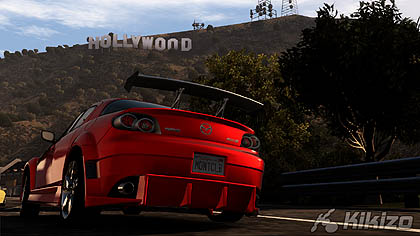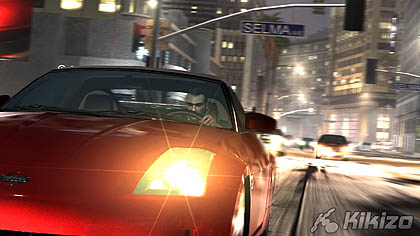First-Hand Preview: Midnight Club: LA
If you weren't bothered about Rockstar's racing series before, you will be now that's it's been totally reinvented for next-gen consoles and looks truly stunning.
Page: 1 2
By Adam Doree
Let me be honest: I've never been that bothered about the Midnight Club series, especially as a bigger fan of Project Gotham Racing since its inception on the Dreamcast. But forget everything you know about Midnight Club to date. I did, as soon as Rockstar recently showed me what they have brewing with the first in this reinvention of the series: Midnight Club: Los Angeles. It's looking simply awesome, and I guarantee that any race fans previously indifferent towards MC will change their minds pretty sharpish, once they get their first taste of what is sure to become a more significant brand to Rockstar than it was before.

The first thing to forget about is dark, gloomy streets. I like some visual variety and vibrancy in my arcade racers, and despite sticking with the name 'Midnight' Club, the first change is that the game is now set in daylight. Not just daylight actually; there's a 24-hour day-to-night cycle, so where Midnight Club: DUB Edition dabbled with dawn and dusk races, there's now an in-game clock, so you're going to be able to race at any time of day, regardless of specific races.
The next thing to forget about is so-so last-gen visuals. Midnight Club LA is a visual BEAST of a game. With it running on the RAGE engine, which powers Rockstar's Table Tennis and also the forthcoming Grand Theft Auto IV, you can in fact expect a very similar visual quality to the in-car segments of GTA4 - scenes which we have already given high praise to in our first-hand GTA4 coverage earlier this year.
Rockstar's San Diego development studio has been crafting the series since the beginning on PS2. And as it turns out, the RAGE engine was in fact developed by Rockstar San Diego as well. You could that RAGE is 'their baby', and they're using it to great effect here. "We want to use the engine to do different things that will draw the gamer in and make them move in their seat," Rockstar told us. They've added a lovely cockpit view, from which you can look left and right in first-person and see what's going on around you, and where you can see dials reacting to what the car's doing - as you change gears, the revs will drop and go flying straight back up again.
The 'cinematic' in-game camera also makes this racer stand out from the crowd; it 'skids' behind the car as you sway around corners - sometimes all the way around to the side of the vehicle. It's not overdone and the effect really works nicely. The driver is fully rendered, almost to the quality of Niko in GTA4, and on the road, other cars spin out of control very convincingly. Frankly, with everything that's going on at once - at breakneck speed, no less - the overall effect looks even better than PGR4, although both run at 30fps. Because the build we saw was quite early, there were no pedestrians in Los Angeles, but Rockstar assures us there will be in the final game. But thanks to this game's RAGE-powered additions, you're sucked into the game a lot more than in previous Midnight Clubs.
Another thing to forget about is the linear structure and yawn-some menu screens of any previous Midnight Club (or most other racers for that matter). The emphasis is on no rules, zero load times and no menu screens. At the very first moment of the game, this fact becomes impressively clear: the game map isn't actually a menu screen. It's a realtime overhead view of Los Angeles, the interactive city you're about to cruise around and race in. The camera literally zooms in from this satellite view, through the clouds and down to street level and right behind your car in two seconds - it makes you do a double take, and basically sets the standard for the visual polish to expect throughout the game. In our demo, we had just zoomed right down to Sunset Boulevard next to the Chateau Marmont hotel.
Rockstar San Diego has made beautiful versions of Tokyo, Paris and Detroit in the past, and now it's time for Los Angeles to get its big showcase. As much as these cities have always resembled their real-world counterparts, they're not exact recreations in the strictest sense; the priority is on fun and gameplay, but that's not to downplay how much it does look like the real thing. Sunset Boulevard actually looks like Sunset. And what about the Convention Center? (We kind of miss it since the Old E3 died). "Maybe... I know the Staples Center is in there," we're told...
The whole city is at least as big as DUB's three cities combined - which is pretty damn huge, basically. And it's a city that's entirely open right from the start - you don't have to unlock areas of it - you can go wherever you want, whenever you want. This is because, again, MCLA basically does away with menu screens. You can pretty much progress all the way through the game without leaving Los Angeles; you can drive around and go up to opponents, using the aerial view to see where they are. You can flash your lights at them, instigate a race, and then you've got a 'mini race' over to the start point, which is pretty cool, and then the race starts proper.
Page: 1 2













 Satoru Iwata Video Interview - the late Nintendo president spoke with Kikizo in 2004 as 'Nintendo Revolution' loomed.
Satoru Iwata Video Interview - the late Nintendo president spoke with Kikizo in 2004 as 'Nintendo Revolution' loomed. Kaz Hirai Video Interview - the first of Kikizo's interviews with the man who went on to become global head of Sony.
Kaz Hirai Video Interview - the first of Kikizo's interviews with the man who went on to become global head of Sony. Ed Fries Video Interview - one of Xbox's founders discusses an epic journey from Excel to Xbox.
Ed Fries Video Interview - one of Xbox's founders discusses an epic journey from Excel to Xbox. Yu Suzuki, the Kikizo Interview - we spend time with one of gaming's most revered creators.
Yu Suzuki, the Kikizo Interview - we spend time with one of gaming's most revered creators. Tetris - The Making of an Icon: Alexey Pajitnov and Henk Rogers reveal the fascinating story behind Tetris
Tetris - The Making of an Icon: Alexey Pajitnov and Henk Rogers reveal the fascinating story behind Tetris Rare founders, Chris and Tim Stamper - their only interview? Genuinely 'rare' sit down with founders of the legendary studio.
Rare founders, Chris and Tim Stamper - their only interview? Genuinely 'rare' sit down with founders of the legendary studio. The History of First-Person Shooters - a retrospective, from Maze War to Modern Warfare
The History of First-Person Shooters - a retrospective, from Maze War to Modern Warfare